Updated March 2, 2024
Are you looking for a November or Thanksgiving craft for your toddler?
You are not alone!
Today we are sharing cork stamping Indian corn for toddlers.
November is the month when the days get much shorter in New England.
It is very often cold, rainy, and windy, and occasionally snowy as we head into Thanksgiving week.
We do a lot of indoor activities in November.
Arts, crafts, and sensory play are our favorites.
November themes for our kids revolve around animals preparing for winter, weather, the end of the harvest season, and of course Thanksgiving!
We love this Indian corn painting craft for Thanksgiving week, but it is a fun project during any time of the fall.
So let’s jump into the supplies and direction for this easy fall toddler craft.
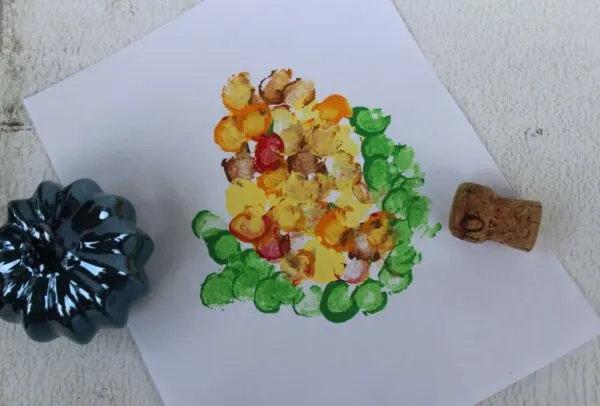
Cork Stamping Indian Corn For Toddlers
If you’ve seen our Apple Tree Cork Stamping post, you will know how to do this one too!
If you haven’t, then this is a great introduction to cork stamping, which is an incredibly simple and fun arts and crafts project for your toddler.
If you have a cork from a bottle of wine or something else lying around, along with some paper, and paint, you can do this one easily.
We chose Indian corn because it’s a fall staple, a simple image, and with plenty of varying colors.
Your toddler will have a great time stamping the paper, creating a great fall art piece that will really help ring in the season!
Supplies:
The biggest positive of cork stamping is how incredibly low the barrier to entry is!
All you need is a cork, paint, paper, and a plate to pour the paint onto.
These are all fairly common if you have a toddler in the house.
For this Indian corn, we used red, orange, yellow, green, and brown paints.
A paper plate
A cork
Paper
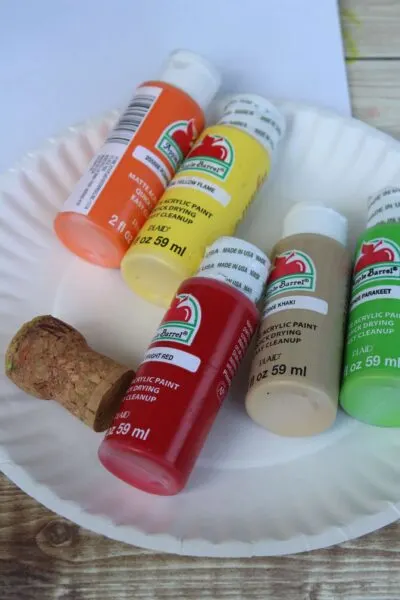
Directions
Pour a quarter-size dab of paint in each color onto a paper plate.
Using a cork, begin to shape the green husk of the corn.
To make it easy for little ones, you could ask them to stamp the shape of a U onto the paper.
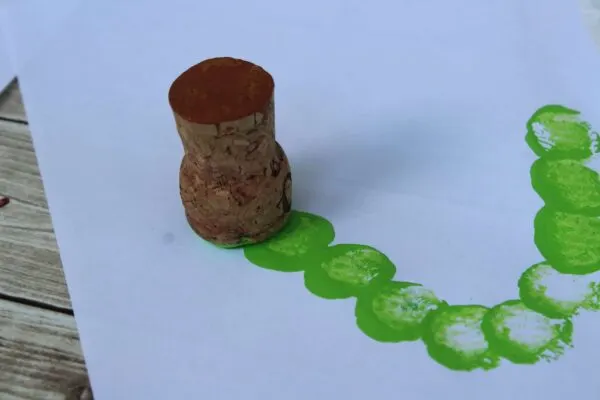
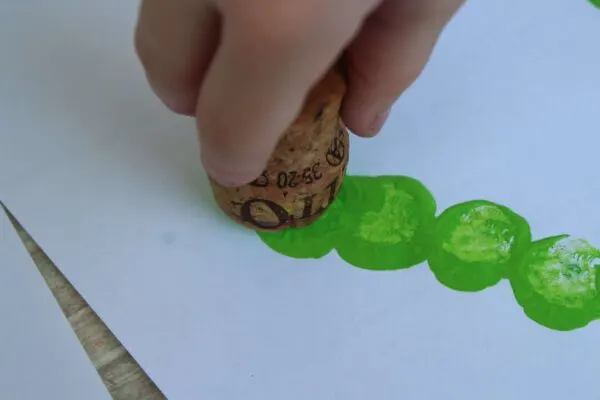
Now, ask your little artist to begin stamping, using one color at a time, to fill in the ear of corn.
If you want this project to be more process-focused than product-focused for your toddler you can skip these directions.
You can let your toddler entirely create their own design if you’d like.
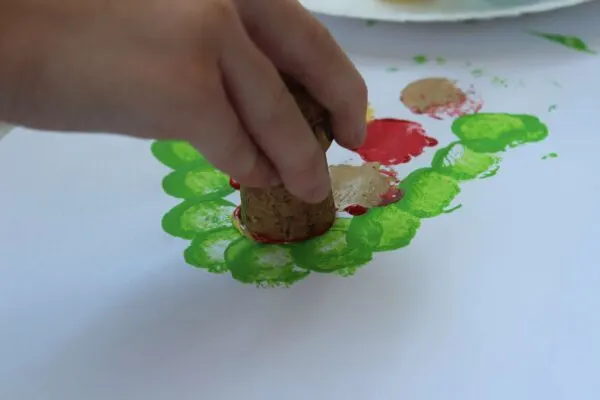
Ask your artist to use each color several times.
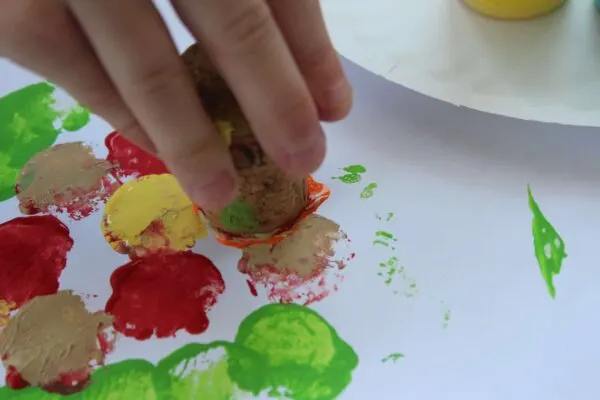
Allow to dry and display.
You can put this painting in a frame and use it as part of your Thanksgiving decor!
Our kids love when we display their art and crafts.
Yours will too!
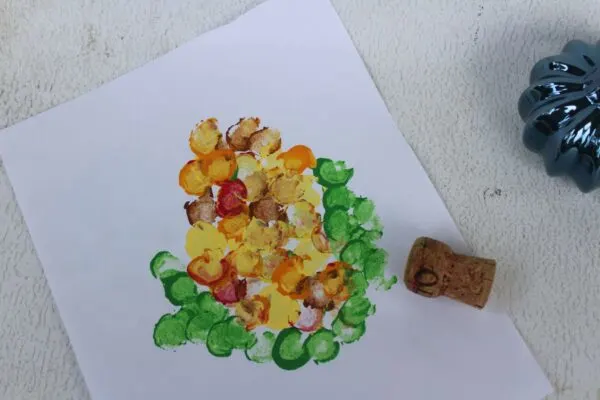
Tips for making arts and crafts enjoyable for your toddler:
- Play music! Toddlers are at the right age to really begin enjoying music, and it’s a huge part of childhood development!
- Art and music flow together. Let your child choose the music they’d like to listen to.
- Encourage movement. Taking breaks to get up and move around a little is always important.
- Discuss their art with them. Write down the words they use to describe their art if they want you to.
- Allow them to do more than one art project. While it’s nice for them to focus on one specific project, if they’d like something like paint and paper to do something else with, you should give it to them.
- If the weather allows go outside and do art projects outside in nature. Fresh air and exercise are always appreciated, and the environment might give some much-needed inspiration for arts and crafts!
- Laugh, sing, and smile.
- Take nature walks and collect items like leaves, feathers, flowers, and rocks to use in art projects. The fall season is perfect for this, even if it can get a little chilly outside.
We try to tie literature into all of our other activities.
These are some of the fall books we have loved.


The best way for young children to learn is through play and doing activities that bring them joy.
Since arts and crafts require working with objects, it teaches toddlers about different shapes, textures, and colors.
They will also learn how things work and how they match.
Creativity is also developed from arts and crafts, as it encourages kids to experiment and play in a relaxed and fun environment.
Process art vs. Product art for toddlers
Earlier, we discussed how this craft was a product-focused project where you guide your toddler to the outcome. In this instance, cork stamped Indian corn was the desired outcome.
We try to be mostly process-oriented in arts and crafts with our toddlers and preschoolers. Art is about them exploring and sharing their vision and thoughts.
But, there is nothing wrong with doing some product-focused art that is age-appropriate with your kids.
I decided this fall we would do several product-focused art and craft projects along with our process-oriented artwork.
I’m a former preschool teacher who became a nurse, so I’m finding my way through toddler life one experiment at a time with our children.
You should do the same! If you always do product art projects, switch it up and do some process art with your toddlers or vice versa.
What is process art?
Process art is simply the art that does not focus much on the end product but rather on the activities leading to the product.
In this regard, process art focuses on the creative aspect of the child rather than the results obtained.
In addition, process art has some characteristics that differentiate it from other forms of art.
This art is more experimental, open-ended, creative, unstructured, and self-motivated.
You don’t give many directions, you don’t have a sample project they can follow.
The focus is on the experience while it is happening not a pre-planned outcome.
Naturally, children are attracted to art and usually perceive it as the best form of expression as they uncover different possibilities and explore materials of unique kinds.
As a parent, you may need to lead and guide your toddler in process art and observe how the toddler manipulates the available objects.
You don’t want your toddler to become frustrated.
As a result, you will better understand your child’s ability and provide help if they need it.
An artist named Robert Morris invented the term Process art when he was working in a Museum in the year 1968.
He started experimenting with soft felt by celebrating how it impacted stress.
He had a simple task: he cut and dropped pieces of felt scraps on the floor, making it colorful.
This art is also referred to as Post-Minimalist or Anti- Form art.
We love this book for introducing young children to art:
Process art is instrumental in children learning because it allows young children to realize, explore and expand on creativity in unrestricted means.
In this kind of art, you are an observer as you only provide the essential material.
You don’t need to give verbal instructions nor engage in creative activities.
Unless your toddler needs a little guidance on how to start.
Cork stamp painting is a fun toddler fall art activity, but did you know it is also an excellent fine motor activity?
Your toddler will practice grasping the cork, picking it up, and putting it down without dropping it.
This is an important early learning skill for your 2-year-old to practice.
What are Fine Motor Skills?
Fine motor skills are essential for using the small muscles in fingers, hands, and arms.
These muscles are important during activities such as drawing, buttoning, constructing with blocks, and zipping up a coat.
Fine motor skills impact your child’s ability to do the above types of activities and their speed to complete them.
To ensure your child performs these tasks successfully, they will need lots of opportunities to practice and gain mastery in the early toddler years.
Some of the common fine motor skills are:
- Pencil skills like coloring and drawing
- Scissor skills such as cutting and rearranging the paper
- Doll dressing and manipulation
- Dressing, i.e., zips, buttons, lacing, and tying shoelaces
- Basic hygiene like brushing teeth, washing their face, and combing their hair
- Construction skills such as puzzles and Duplo
Why are fine motor skills important for toddlers?
It’s hard not to emphasize the importance of fine motor skills in everyday life because they enable us to perform simple tasks.
If a child is unable to complete the basic everyday tasks, it will take a toll on their self-esteem, affecting their play, academics, and co-curricular activities.
Also, children without the appropriate fine motor skills will find it hard to get independent life skills such as feeding or dressing, which will have many implications on relationships with other peers.
That is why fine motor activities are so important for your toddler to get plenty of opportunities to engage in.
Thankfully, there are amazing activities that you can do to help kickstart those developments outside of normal day-to-day life.
Arts and crafts often require children to use their hands in a specific manner; through this coordination, they will develop bilateral coordination and fine motor skills.
For instance, drawing lines and dots, tearing a piece of paper, or cutting it with shears are demanding assignments in terms of mastery, and children enjoy doing them.
Such tasks can help a toddler develop faster and become more skilled in other everyday activities like dressing.
This Indian corn cork stamping craft will be a November favorite for your toddler!
The simplicity, lovely fall colors, and easily displayable painting come together to form the perfect November fall arts and crafts project.
Your toddler will almost certainly enjoy doing this with you, and you’ll end up with some great memories.
Be sure to hold onto the painting, it’ll help bring those memories rushing back whenever you find it or look for it again.
Thank you for checking out this amazing arts and crafts project, if you’re looking for other fall-themed arts and crafts projects we have plenty for you!




